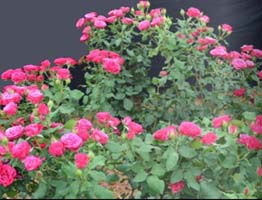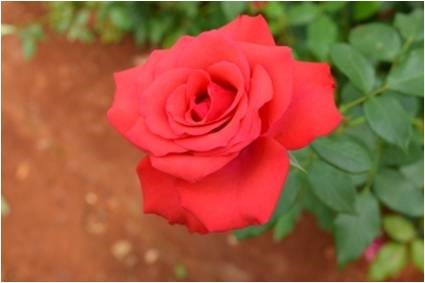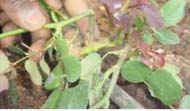cultivation practices
-
soil & climate
Deep (upto 50 cm) loam soil rich in organic matter with pH of 5.5 - 6.5 is ideally suitable for rose cultivation. The growing medium may consist of soil, sand and FYM in the ratio 2:1:1. In place of sand, sawdust can also be used. Rose cultivation can be taken up ideally in cooler climate with bright sunlight. Places with day temperature ranging between 25-30oC and night temperature of 15-18oC are suitable for rose production. When the temperature increases above 30oC, care has to be taken to provide high humidity and to reduce the evaporation loss.
-
propagation

Rose plants are propagated by budding or top-grafting on rootstocks like Rosa indica, R. multiflora, and R. canina. ‘Nishkant’ variety of rootstock without any prickles and easy to bud with high bud uptake. Budding in polybags is ideal for easy transportation of material. Budded plants of 3 months old are used for planting. For bare rooted plants, budding has to be taken up in soil and can be shifted 6 months after budding.
-
Planting: For cut flower production
Planting is taken up in well - prepared, raised beds of 1.0 m width and 30-40 meter length. For necessary cultural operations, 50 cm path can be accommodated between the beds in a bay of 6.4 m or 8 m width. There are two rows in each bed with 20 cm and 25 cm spacing between the plants in a row, respectively in polyhouse and field. This accommodates 60-70 thousand plants per hectare, respectively.
-
Planting: For loose flower production
Planting can be taken up in rows with spacing of 2 meter between rows and 1 meter between plants. Depending on the spacing, holes or trenches of 1-2 feet depth are dug to fit roots in the proper position unbent. Soil should be moist at planting. After planting, it is advisable to provide maximum humidity either with misting or with a hose pipe so that the soil settles around roots with no air pockets. Care must be taken to ensure that the bud union is 2-3 cm above soil.
-
IrRigation

Drip irrigation of 4 - 6 litre of water/ m2/ day is optimum. However, depending upon temperature, relative humidity and light conditions, this can vary.
-
Nutrient requirement
Organic manure @15 kg/m2 is added and mixed with the soil at the time of bed-preparation. A fertilizer dose of 400:320:600 kg NPK/ ha/ year is recommended with basal application of 2kg Superphosphate,1kg Calcium Ammonium Nitrate and ½ kg of Muriate of Potash/10m2 before planting. Remaining quantity of N and K is supplied through biweekly fertigation with N at 1.92 g/m2 and K2O at 2.88 g/m2/fertigation using water soluble fertilisers. Micronutrient formulations @ 2g/l or individual nutrients are supplied through foliar spray or fertigation. Regular analysis of soil, water and leaf will be good guide to supply optimum nutrients.
-
Harvesting
Stage of harvest varies with the variety and distance to the market. For cut roses, flowers are harvested at the tight bud stage with all sepals unfurled. Harvesting is done either in the early morning or in evening hours and the produce is placed immediately in buckets containing clean water. The flowers are precooled before and after grading, packed in cardboard boxes and transported in refrigerated vans. Loose flowers are harvested at the initiation of flower opening.

 Rose is the most beautiful having different shape, size
and colour.
Roses are grown for loose flower and for cut flower. Cut
flower cultivation can be taken up in polyhouse to get
long stalk and big flower buds. In cooler climate, even
long stalk cut flower production can be taken up in open
field.
Rose is the most beautiful having different shape, size
and colour.
Roses are grown for loose flower and for cut flower. Cut
flower cultivation can be taken up in polyhouse to get
long stalk and big flower buds. In cooler climate, even
long stalk cut flower production can be taken up in open
field. 